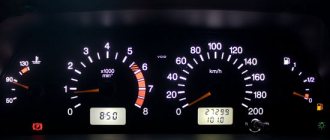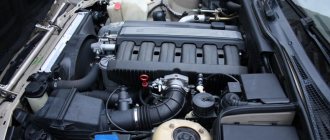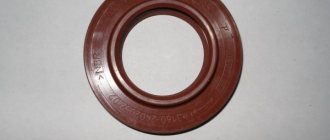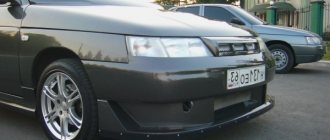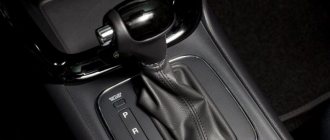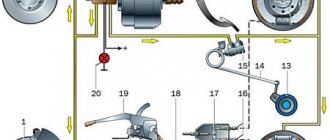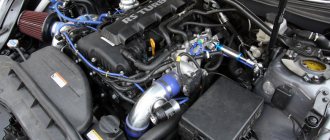Any driver is very alarmed by situations when vibration appears at a speed of 100-120 km/h on the steering wheel or along the body. And the point here is not only about discomfort, although it must be said that these symptoms are a rather unpleasant phenomenon. If measures are not taken to correct the problem in time, this may lead to a violation of the geometry of the body. This will not happen immediately, but slowly and gradually.
Distortions can provoke a violation of the aerodynamic characteristics, as well as deterioration of the vehicle's handling. In addition, due to vibration effects, cracks can form in the metal, which is not only dangerous in itself, but also requires expensive repairs.
And that's not the whole problem. If the car vibrates at a speed of 100-120 (VAZ 2110 is no exception), this leads to the loosening of various fasteners. This phenomenon can lead to serious consequences - accidents, as well as various malfunctions and damages, which will be very difficult to eliminate. It is worth adding that this kind of shaking is a signal of breakdowns that will yet occur in the near future.
Vibration at speeds of 100-120 km/h occurs for various reasons. These may be completely harmless problems. But sometimes there are serious cases that require global intervention in the technical structure of the car. Further in the article we will look at the typical reasons why vibration is transmitted to the steering wheel and car body at high speeds.
Balancing is out of balance
If there is vibration in the steering wheel at a speed of 100-120 km/h, the first thing you should do is inspect the wheels and tires. They're not perfect. The discs may be uneven or uneven in composition. Since the weight is different in different places of the tire or disk, during the rotation process the place where the mass is greater will pull the center of gravity towards itself. This is nothing more than the effect of centrifugal force. Accordingly, at high wheel speeds, this impact will necessarily be transmitted through the rack and rods to the steering wheel. In case of other damage for the same reason, vibration will also occur on the body.
What is the way out of this situation? The driver needs to balance the wheels. It's better to do this periodically. Balancing is also required when “re-shoeing”. What is this process? This is equalizing the weight of the wheel at each point. If violations are detected, the specialist sticks special weights on the disc.
It is impossible to operate a car for a long time on unbalanced wheels. This can cause severe wear in certain areas of the tire, which will increase vibration. Also, because of this, almost all components and suspension units of the car wear out excessively. The hub bearings are also subject to heavy loads.
The main causes of vibration in a car
p, blockquote 15,0,0,0,0 —>
The main causes of vibration in a car are associated with mechanical, sound and resonance phenomena. Since the vehicle moves as a whole during operation, the source of vibrations can be almost any element of its structure. The most common and noticeable sources of vibration in a car by the driver are:
p, blockquote 16,0,0,0,0 —>
- Vibration of a car engine, gearbox, clutch
. It can occur due to engine tripping (inoperability of one or more cylinders). It appears at idle or low speeds in the form of uneven vibration of the body, gear lever, and interior elements. It may also be a consequence of uneven supply of fuel, air, or misfires. Vibration can be caused by vibrations in the flywheel, clutch system, or gearbox. In the high-frequency audio range, it is often caused by wear on the alternator belt.
- Engine mounts.
When the engine mounts are worn out or damaged, the oscillatory movements of the engine are directly transmitted to the body. In this case, the engine seems to knock on the body. Sound and mechanical vibrations are perceived by drivers like the sound of a jackhammer. At certain engine speeds they can increase many times over due to resonance phenomena.
- Cardan shaft in rear-wheel drive vehicles.
Occurs when the geometry of the cardan system or rear axle changes. The frequency directly depends on the vehicle speed. It is clearly noticeable in the form of a hum at speeds of 50 km/h.
- Body parts.
If parts are poorly secured or some elements are corroded, mechanical vibrations may occur, which can be amplified by resonance phenomena. Mechanical vibrations of body elements lead to their damage. The body part may simply fall off.
- Wheels.
When replacing or repairing wheels, mandatory balancing is required. During the operation of the wheel it may be damaged. Radial vibration of the wheel can be damped by the car's suspension and is almost imperceptible to the driver. It is almost invisible, but if present, it leads to a malfunction of the suspension system and a reduction in the service life of the hub bearings. Transverse wheel vibration is reflected in steering beats and leads to premature wear of the steering rack and rods.
Video - why the car shakes at speed with a beat on the steering wheel:
p, blockquote 17,1,0,0,0 —>
p, blockquote 18,0,0,0,0 —>
- Suspension elements.
The suspension of modern cars is a complex mechanism. Wear of even one element can lead to mechanical vibrations, which in turn lead to further damage.
- Steering elements.
As a rule, it is a consequence of rack malfunctions. It manifests itself in the form of steering wheel beating and is extremely dangerous.
- Brake system.
Occurs when brake discs and pads wear unevenly. Such vibration must be eliminated immediately.
- Interior elements.
Most often it manifests itself in the form of rattling, creaking of plastic elements of the interior, upholstery, and other elements. It is not so dangerous, but it causes significant discomfort during operation of the machine. Often, to eliminate it, it is necessary to apply sound insulation to the car.
Symptoms of imbalance and diagnosis
You can determine if the balance is out of balance when driving at high speeds. In this case, vibration will be felt on the steering wheel or on the body. The problem can be diagnosed using a visual inspection. Wheel rims should be as smooth as possible, without dents. If the car has not recently driven at speed through potholes, and slight vibration is felt on the steering wheel and body, then most likely the problem is imbalanced balancing.
However, you should not think that if the steering wheel shakes, then it is enough to give only two front discs for balancing. Often the only way to fix a problem is to balance all four.
Methods to combat steering wheel vibration:
- bent driveshafts and front wheel drives are simply discarded and sent to scrap for re-melting;
- worn out, deformed and “woody” rubber-metal silent blocks in the suspension are replaced with new ones;
- Of course, the lower ball joints experience the greatest load, but over the years, play also occurs in the upper ones; all worn parts are defective and replaced with new ones - I especially emphasize : never agree to a replacement and never buy restored and/or repaired front suspension parts, life is more valuable;
- the same applies to the tie rod ends together with the steering rack; only if there is a suspicion of emerging play, the tips (and associated pairs of the steering rack) should be replaced;
- if the steering wheel shakes when braking, then it’s somehow indecent to talk about worn brake pads and discs; their replacement is obvious and unambiguous;
- Wheel balancing should be carried out 1 (one) thousand kilometers after replacing tires, and then - visit a tire service every 5 (five) thousand kilometers, regardless of whether steering vibration appears or does not appear.
The wheel alignment is broken
Directly depending on the incorrectly set angle, vibration can only occur during acceleration or in a certain speed range. Incorrect wheel alignment can be detected very quickly - tires wear unevenly.
If only the outer or only the inner part is wiped, then this is the same situation. The problem can be corrected by adjusting the angles. Then the vibration in the body at a speed of 100-120 km/h will disappear.
Vibration in the body and deformed rims
Often the cause of unpleasant vibrations is disc deformation. This is easily determined on balancing stands. Most often, deformations occur due to driving through potholes. The problem occurs in the spring, when their numbers increase.
If it is not possible to go to the stand, then you can try to find the dent visually. Most severely, the disc jams from the inside. Stamped steel wheels are more likely to deform than their cast counterparts.
In addition to dents, vibration at speeds of 100-120 km/h can also be caused by simply a curved disk. At the same time, the wheel can rotate smoothly on the stand. This is because it is attached to the device through the central hole. On a car, the wheel is not centered when installed. Warped discs also come from the factory.
Chassis
Here, just like with wheels, several reasons can be identified. So, when the drive shaft bends, vibration will certainly occur on the wheel. This will be indicated by constant shaking when starting to move. Its strength will increase with acceleration. At a speed of 100 km/h the car turns into a rattle. And if you accelerate even more, the car leaves a straight path.
Often vibration at speeds of 100-120 occurs after replacing brake discs. Shaking will alert the car owner that the disc is not securely fastened. At speed, the disc suffers from play, which affects the body and steering wheel.
CV joints are another reason. You can check this element very simply. It is enough to take the articulated shaft and try to turn it. If play is observed, even if small, the CV joint must be replaced. An additional sign is a torn boot.
And, of course, it's worth checking the wheel bearings. If they are damaged, the body will definitely vibrate. Shaking is felt at any speed.
Ways to solve the problem
Whatever the reasons for the steering wheel beating, it is necessary to carry out high-quality diagnostics and eliminate the problems. This will make it possible to avoid expensive repairs, and most importantly, prevent accidents!
If the steering wheel shakes at low speed, proceed as follows:
- check the cleanliness of the wheel rims;
- check the balancing and fastening of bolts on the wheels;
- test discs for deformation;
- check the quality of rubber;
- diagnose the suspension;
- examine brake discs and drums;
- check the engine mounting;
- try the quality of the drive shaft.
Wheel rims are easier and faster to clean at a car wash. A stream of water will remove accumulated dirt. Hit the disc with some object, reducing the amplitude of vibrations of the steering wheel, in order to safely drive to the car wash or service station.
Have your balancing done at a tire shop. Balance all 4 wheels, especially if the steering wheel shakes at low speeds. At the same time, eliminate the deformation of the wheel rims and give them their initial shape on a straightening machine.
Replace defective tires. It will not be possible to restore it - you will have to buy new tires and mount them according to the canons of proper balancing.
The beating that occurs during braking can be eliminated at a service station. The machine grinds and restores the surface of the brake discs if the degree of wear is low.
It is better not to fix steering wheel wobble at speed yourself. Only car services will accurately determine the cause of the breakdown and eliminate it. Most workshops work with specific brands of cars; they have a better understanding of the specifics of the models, know the characteristic “sores” and are able to quickly recognize them.
Worn suspension
Heavily worn chassis components can cause vibration in the steering wheel. Suspension affects the vehicle's contact with the road. If there is play in the chassis, then this is the cause of the imbalance during rotation. But suspension play is only a “catalyst” for wheel vibration. It in itself cannot serve as the main reason for steering wheel vibration.
Speeds of 100-120 (VAZ - 2108 is no exception) can demonstrate it to you when the car has a faulty steering mechanism. It is necessary to eliminate these breakdowns first. It may be dangerous. However, problems should be diagnosed last, if all other components are in perfect order.
Causes of steering wheel beating when braking and turning
Steering wheel wobble at speed often begins due to the fault of the car enthusiast himself. He is inattentive to his duties and does not check the wheels before driving. The steering wheel often shakes at low speeds due to loose wheel bolts. The malfunction gets worse when braking, and the situation becomes extremely dangerous when cornering.
Steering wheel vibrations can also occur due to problems with the car’s suspension. The presence of backlash or failure of one of the chassis elements leads to imbalance.
First of all, determine whether the brake discs are faulty if the vibrations increase during a sudden stop of the car. Problems with the brake drum or disc are among the common causes. Parts become unusable, waves or other defects appear on them. Therefore, you should not overheat the brake elements too much (hold the brake pedal for a long time on a descent) or cool them suddenly (driving into a puddle).
If vibration increases when turning the steering wheel or during other maneuvers, a preliminary inspection is necessary. It will be impossible to find out the reason without this. First of all, check the rods and tips, hubs.
Wheels are loose
This problem is easy to identify and fix, as it causes vibration at speeds of 100-120. The VAZ-2110 will make a characteristic dull sound. The problem is the loose nuts and bolts securing one wheel or several. Do not neglect checking, it can be dangerous. The wheel may simply unscrew while driving.
The beating itself is very reminiscent of vibrations on the steering wheel and body when the reason was in the wheels and tires. The difference here is that this shaking begins at low speeds. This phenomenon can be observed at different speeds.
So, we found out for what reasons vibration occurs on the body when driving at speeds of more than 100 kilometers per hour.
To post a reply you must log in or register.
Steering wheel wobble when driving due to damaged or poor-quality discs
Both in the VAZ 2110 and other cars, steering wheel vibration at speed can occur due to the fact that the wheels are curved. Any specialist in tire fitting will notice this fact. In addition to dents, there may also be factory distortions on the wheel. If your tires have already served you for several years, they are quite old - this can negatively affect the full operation of the steering wheel. Common signs of tire deformation include:
- poor, worn condition of the cord;
- potholes in the tires due to the fact that you previously fell into holes at speed;
- poor quality production, which can manifest itself in different ways.
Posts 1 to 20 of 32
1 Topic by serega 2012-02-24 19:48:35
- serega
- New member
- Inactive
- Registration: 2012-02-24
- Messages: 38 Thanks : 2
Topic: Resolved: Steering wheel vibration at 100 km/h
Help. it's impossible to drive. When accelerating at exactly 100 km/h, a strong vibration of the steering wheel begins. It feels like the wheels are going to fly off. I've already changed the tires, done the balancing, done the alignment, but it's useless. Maybe someone can tell me where to go.
2 Reply from Admin 2012-02-25 06:38:26 (2012-02-24 20:52:01 edited)
- Admin
- Administrator
- Inactive
- Registration: 2012-02-20
- Messages: 3,257 Thanks : 623
Re: Resolved: Steering wheel vibration at 100 km/h
vibration is vibration. vibrations can only be caused by a rotating wheel that has an imbalance. in practice, it turned out that at a speed of 90-110 km/h the rotating wheel creates resonance, which is why we feel vibration on the steering wheel. at other speeds the wheel also wobbles, but due to the lack of resonance we don’t feel the wobble. Start with something simple ( clean all the dirt inside the wheel rim and balance all the wheels on a good, proven stand ). If that doesn’t help, then look at the suspension , maybe a bearing has worn out. There are no miracles


